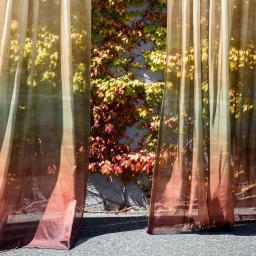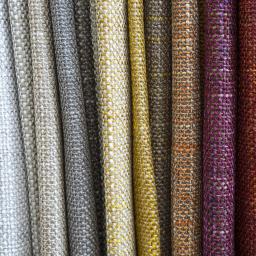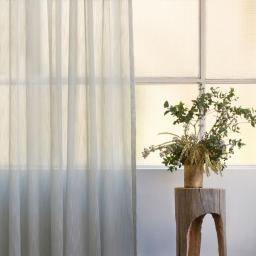Increasing the lifespan of your textiles
- AN EDUCATIONAL YARN -
As well as focusing on the aesthetic and functional needs of interiors, it is important to understand that all fabrics have different qualities and constructions which can be affected by the environments they are installed in. In our next topic for our blog series – An Educational Yarn - we look at these common issues and how we can increase the lifespan of textiles in our interior applications.
- STABILITY & MOVEMENT -
Best choice: Polyester, acrylic, cotton and blends
Caution: Silk, linen, viscose in lightweight constructions.
Fabric stability is particularly critical for curtains and blinds and while a degree of tolerance is essential because all fibres expand and contract as a result of atmospheric changes, some fibres are more affected than others.
Generally fabrics alter in length when they absorb or release moisture. Fibres that release a lot of moisture will obviously ‘move’ more. Most natural fibres absorb moisture readily, which is why they are used for towels etc. Synthetic or man-made fibres have very poor absorption which can make them uncomfortable to wear, but in furnishings they ‘move’ less. However, other factors must also be taken into account such as location, for example the proximity to the sea.
As sea air is heavy with salt, being anhydrous (it absorbs water), when this adheres and settles amongst the fibres, this will naturally attract moisture and this will cause additional weight.
- DURABILITY / PILLING -
Though this applies mainly to upholstery fabrics, pilling and abrasion damage can also occur in drapery if there is constant rubbing against walls and frames. Different weaves greatly affect a fabric’s performance, such as the density of weave and the number of floating fibres, but if woven for a situation where strength and abrasion resistance are the prime consideration, then cotton, linen, polyester, nylon, acrylic and wool can make strong and durable upholstery fabrics. Nylon particularly, when even 10% is blended with cotton or linen, produces a far more abrasion resistant fabric.
While the above are guidelines, understanding the properties of fibres will help in discerning their suitability in certain situations.
Many fabrics contain combinations of yarns in order to achieve the best performance and effect.
Abrasion ratings are part of assessing upholstery fabrics, but understanding ratings of tensile seam slippage and pilling is also critical. Quality suppliers with reputable brands and standards will supply only ‘fit for purpose’ products.
- HUMIDITY -
Best choice: Polyester, acrylic
Caution: Cotton, wool, silk, viscose, linen
In humid conditions, bacteria, fungi (mildew) and sometimes moth larvae can create unsightly problems and in some cases totally destroy the fibres. Generally mildew thrives on natural and cellulose fibres e.g. cotton, silk, wool, linen and viscose.
While good air circulation in a room coupled with hanging curtains at least 10 cm from the glass helps, selecting fibres such as polyester and acrylic, which are mildew resistant, is a better option. However, even this may not completely eliminate the problem.
While mildew will not grow on these fibres, it will grow on dust or dirt which may become trapped between the fibres. Regular vacuuming and washing or dry cleaning will help prevent this but in extreme conditions, this is no guarantee. High levels of humidity are the largest contributor to drapery movement.
TIPS: In curtaining, unless the fabric is a sun filter or sheer, it should always be lined. An allowance must be given for a certain amount of movement as a result of atmospheric conditions.
Considering all the different fibre characteristics, the blending of different fibres into yarns and the combining of different yarns into fabrics can overcome many of the disadvantages of specific fibres.
- SUNLIGHT & UV DEGRADATION -
Best choice: Acrylic and polyesters blends
Caution: Silks, wools
While Southern Hemisphere conditions can be so severe that virtually no fabric producer worldwide will guarantee their products at the window, with modern technology, beautiful fabrics are being created which will perform well with long-term satisfaction, even in harsh conditions. Sunlight degradation is one of the prime considerations of curtaining and man-made fibres perform well in resisting damaging rays. The fibre most resilient to sunlight damage is acrylic, followed very closely by polyester. If fabrics made from these fibres do experience colour change, the problem will probably be with the dye or cleaning process, not the fibre.
Of the natural fibres, cotton and linen have quite good sun resistance and again, any colour change here is usually the result of dye or cleaning. However, it is recommended that for Australasian conditions, these fabrics should be protected with a quality lining.
Silk is admired for its beauty and luxury, however it is sensitive to UV damage and affected by even reflected light. The addition of coated linings coupled with bumf will help protect the fabric, although the exposed ‘leading edge’ of curtains will likely still deteriorate. Where possible, it will increase the life of silk curtains if they can be stacked beyond the window.
TIPS: If your client insists on using delicate fabrics make them fully aware of the ramifications of their choice by recording any ‘industry performance’ notations in your quotes. This can save a lot of issues later on.
Leading edges of curtains (those facing the windows) are particularly vulnerable to sunlight degradation. To help minimise this effect, it is recommended that curtains be rotated periodically where possible, i.e. the left-hand curtain swapped into the right-hand position, annually. A quality sun filter is also important where sunlight is directly reflecting on the fabric behind the glass.
Rotate furniture cushions frequently to ensure sun degradation occurs evenly.
Using a synthetic ‘band’ of a contrast fabric down the leading edge will help to protect the curtains and can also be a dramatic design feature.
It is important to have a realistic understanding that all fabrics, regardless of dyestuffs used, will eventually fade/deteriorate under direct sunlight over time. James Dunlop Textiles utilise the best standard dyestuffs, and whilst no warranty can be made as to colour fastness because of our extreme UV conditions, they should perform sufficiently under normal conditions provided proper care is taken.
- GENERAL TIPS -
Fabrics manufactured from natural fibres that are not dyed may suffer from after bleaching, causing lightening or a deepening in colour when exposed to natural light. As this is a natural phenomenon, allowance must be made for this unpreventable colour change reaction. Some yarns, such as silk, are even susceptible to indirect UV rays and every precaution should be taken to protect the fabric by the use of a bumf or interlining as well as conventional lining. Even then, colour degradation may still occur over time.
A superior quality lining is always recommended for drapery applications. Depending on the situation, there are many different linings available e.g. coated linings for added insulation and protection, and three pass blackout linings where light control is a priority such as in children’s bedrooms.
Curtains should be hung at least 10 cm from the glass to enable air to circulate. This helps prevent mildew and reduces heat build-up that will also adversely affect fabrics. Regular cleaning of windows is also very beneficial as this removes mildew spores, which can accumulate and transfer onto curtains.
Depending on fibre content, there will always be some movement in curtain length (the longer the curtain, the greater the variation) due to temperature change and the absorption and release of atmospheric moisture from the yarn of the fabric. This is normal for heavy yarns such as cotton.
To maintain and preserve the lifespan of your furnishings, regular cleaning and maintenance should be carried out. Call Curtain Clean for all your needs on 0800 579 0501.
New Year, New Questions You Won’t Solve!
I get smaller every time I take a bath.
What am I?
Do you think you know the answer to our daily riddle? Don't spoil it for your neighbours! Simply 'Like' this post and we'll post the answer in the comments below at 2pm.
Want to stop seeing riddles in your newsfeed?
Head here and hover on the Following button on the top right of the page (and it will show Unfollow) and then click it. If it is giving you the option to Follow, then you've successfully unfollowed the Riddles page.

Share your summer photos! 📷
Taken some beautiful snaps lately? Whether it's rainbows, sunsets or a beautiful summer's day, we'd love you to share the joy with us.
Share a photo in the comments below











 Loading…
Loading…



















